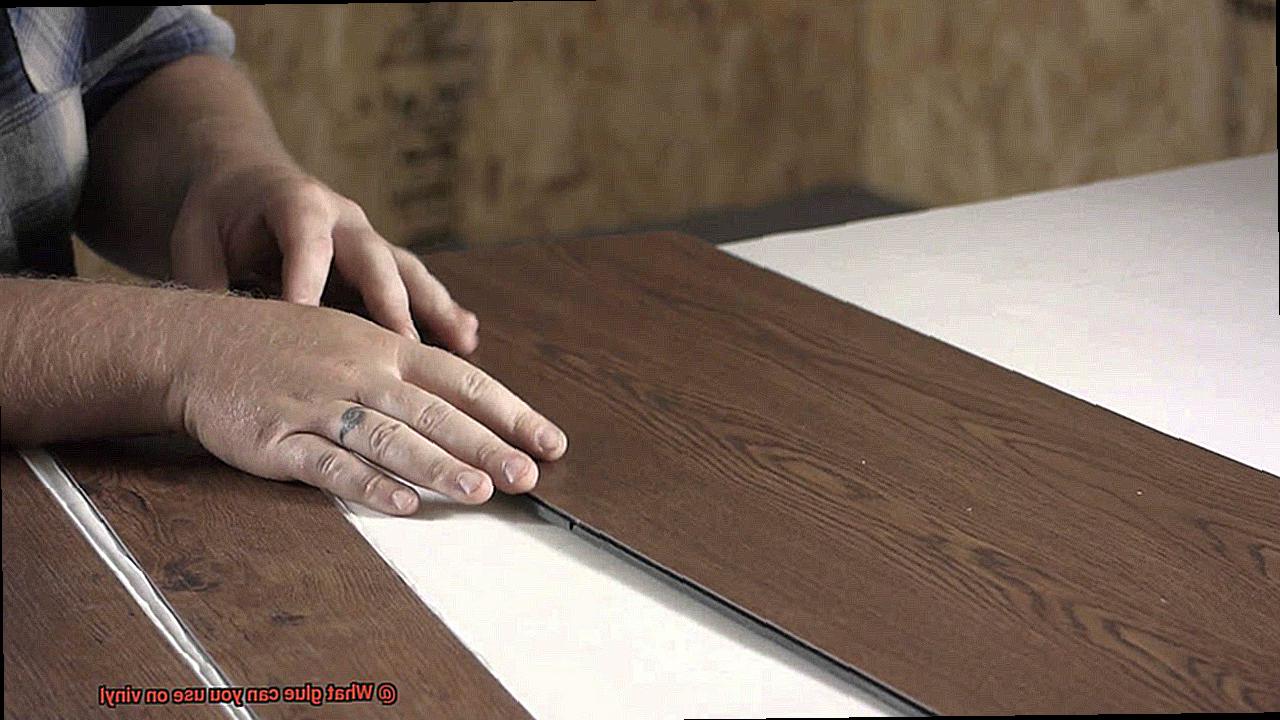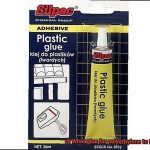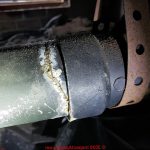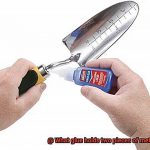If you’ve ever found yourself scratching your head in confusion while standing in front of a wall full of glue options, wondering which one will actually stick to vinyl, then this guide is here to save the day. We’re about to unravel the mystery behind gluing vinyl materials and help you find the perfect adhesive for all your sticky situations.
Whether you’re fixing up a cracked vinyl chair, laying down some snazzy new flooring, or unleashing your inner Picasso with a DIY vinyl masterpiece, having the right glue is absolutely crucial. You don’t want your hard work falling apart at the seams (literally) after all.
So get ready to dive into the world of adhesives as we walk you through the top contenders that promise a rock-solid bond for your vinyl projects. By the time we’re done here, you’ll be armed with all the knowledge and confidence needed to make informed choices and achieve flawless results. Let’s get sticking, shall we?
Types of Glue Suitable for Vinyl
Contents
Well, have no fear, because we’ve got you covered. In this comprehensive guide, we will explore the different types of glue that possess magical properties when it comes to bonding vinyl materials. Buckle up and prepare for an adventure in adhesive excellence.
Vinyl Adhesive: The Mighty Bond for All Things Vinyl
Picture this: you’re in the midst of a vinyl project, and suddenly, disaster strikes. Fear not, for vinyl adhesive is here to save the day. This glue is like a superhero, specially designed to tackle any vinyl project with ease. From repairing your trusty vinyl flooring to creating a masterpiece out of vinyl materials, this trusty companion has got your back. Its strength and durability are unparalleled, making it the go-to glue for all things vinyl.
Contact Cement: A Bond That Sticks in an Instant
In need of a bond that’s as unbreakable as Hulk’s arm? Look no further than contact cement. This powerful adhesive creates an instant bond that will leave you in awe. With just a simple press of the vinyl surfaces together, you’ll witness a bond so strong it could withstand the test of time. Whether you’re attaching vinyl tiles or laminating sheets, contact cement ensures a permanent hold that won’t let you down.
Epoxy Glue: The Heavy-Duty Hero for Industrial Vinyl
When it comes to heavy-duty vinyl projects, epoxy glue is the knight in shining armor you’ve been searching for. Armed with its two parts – resin and hardener – mixed together, it forms a bond that can withstand even the toughest challenges. From industrial settings to heavy-duty vinyl applications, trust in epoxy glue to have your back every step of the way.
Super Glue: Quick and Reliable for Your Vinyl Wonders
Time is of the essence, and that’s where super glue swoops in to save the day. Also known as cyanoacrylate adhesive, this speedy wonder bonds quickly and securely with your vinyl materials. However, a word of caution: always double-check its compatibility with vinyl before inviting it to your crafting party. With super glue by your side, your vinyl wonders will come to life in no time.
Construction Adhesives: Building Bonds That Last
Vinyl isn’t just for crafting; it’s also a key player in construction projects. That’s where construction adhesives come into play. These mighty glues are designed to bond various building materials, including vinyl.
So whether you’re installing vinyl siding or attaching trim, construction adhesives will ensure a strong and durable hold that withstands the test of time.
Solvent-Based Adhesives
These adhesives pack a powerful punch, creating a strong and durable bond that can withstand the test of time. But before embarking on your next vinyl adventure, it’s important to understand the ins and outs of solvent-based adhesives.
Let’s start with the pros:
- Strong Bond: Solvent-based adhesives are renowned for their exceptional bonding strength. Packed with volatile organic compounds (VOCs), these adhesives evaporate during the drying process, leaving behind a solid bond capable of withstanding heavy use and stress.
- Versatility: From flooring to wall coverings and upholstery, solvent-based adhesives like contact cement and cyanoacrylate adhesive are incredibly versatile. They can handle any vinyl project you throw at them, ensuring a reliable and lasting bond.
- Fast Bonding: Need a quick fix? Solvent-based adhesives have got your back. Cyanoacrylate adhesive, also known as super glue, performs its magic with lightning speed. With just a few drops, you can achieve an instant bond that saves you valuable time and effort.
However, there are some cons to be aware of:
- Safety Precautions: It’s no secret that solvent-based adhesives contain harmful chemicals that can be toxic if inhaled or come into contact with skin. Prioritizing safety is crucial. Work in a well-ventilated area, don protective gloves and a mask, and take breaks to avoid prolonged exposure.
- Odor: Solvent-based adhesives often have a pungent odor during application and drying. Allow sufficient time for the adhesive to dry completely and the odor to dissipate before subjecting the bonded vinyl to excessive heat or moisture.
- Compatibility Issues: Not all solvent-based adhesives are created equal. Some may cause discoloration or damage to certain types of vinyl, especially if they contain harsh chemicals. Test the adhesive on a small, inconspicuous area of the vinyl before proceeding with the full application to avoid any mishaps.
Vinyl Cement Adhesive
Choosing the right adhesive is essential for a successful outcome. Look no further than vinyl cement adhesive. In this article, we’ll explore the advantages of using this powerful glue for all your vinyl bonding needs.
Flexible Bond:
Vinyl materials need an adhesive that can withstand stretching and bending without compromising the bond. Vinyl cement adhesive is formulated to create a flexible bond that remains intact even under stress. No more worries about your vinyl projects tearing or coming apart.
Versatility:
Vinyl cement adhesive works on various types of vinyl materials, including PVC, faux leather, and vinyl-coated fabrics. This convenience makes it an excellent choice for a wide range of projects involving different vinyl applications. No need to purchase multiple adhesives.
Durability:
Vinyl cement adhesive provides a strong and long-lasting bond that can endure frequent use and exposure to different conditions. It is resistant to moisture, heat, and chemicals, making it suitable for indoor and outdoor applications. Rest assured your vinyl projects will stand the test of time.
Easy Application:
Applying vinyl cement adhesive is a breeze. Use a brush or applicator for precise and controlled application, ensuring an even spread on both surfaces being bonded. Follow the manufacturer’s instructions regarding drying time and curing process.
Super Glue and Cyanoacrylate Adhesive
When it comes to achieving a strong and durable bond on your vinyl projects, look no further than super glue and cyanoacrylate adhesive. These adhesives are renowned for their quick-setting properties and ability to create secure bonds on various materials, including vinyl. In this article, we will delve into the advantages and considerations of using these adhesives for bonding vinyl materials.
Advantages of Super Glue and Cyanoacrylate Adhesive:
- Lightning-Fast Bonding: The most significant advantage of super glue and cyanoacrylate adhesive lies in their lightning-fast bonding capabilities. Within mere seconds of application, these adhesives initiate the bonding process between vinyl surfaces, saving you valuable time and allowing you to move on with your project swiftly.
- Unmatched Versatility: Super glue and cyanoacrylate adhesive are not limited to bonding vinyl alone. Their remarkable versatility allows them to adhere to various materials, such as plastic, metal, wood, ceramics, and more. This versatility makes them the go-to choice for numerous crafting and repair projects, giving you the freedom to explore your creativity across different mediums.
- Unyielding Durability: Once bonded, super glue and cyanoacrylate adhesive form an unyielding and enduring bond that can withstand everyday wear and tear. This makes them ideal for long-lasting applications like repairing vinyl upholstery or creating durable vinyl crafts that can withstand the test of time.
Considerations for Using Super Glue and Cyanoacrylate Adhesive on Vinyl:
- Surface Preparation: To ensure a successful bond, it is crucial to prepare the vinyl surface properly. Thoroughly clean the surface with a mild detergent or rubbing alcohol to eliminate any dirt, dust, or oils that may hinder the adhesive’s effectiveness. A clean surface sets the stage for a strong and reliable bond.
- Mastering the Application Technique: When working with super glue and cyanoacrylate adhesive, applying a thin layer is key. Excessive amounts can lead to messy application and potential damage to the vinyl material. Mastering the art of precise application will result in a clean and seamless bond.
- Compatibility Testing: While these adhesives are generally reliable for bonding vinyl, it is always wise to test the adhesive on a small, inconspicuous area first. This step ensures compatibility and avoids any potential adverse reactions, especially on vinyl with high plasticizer content. It’s better to be safe than sorry when it comes to achieving the perfect bond.
Preparing the Surface for Bonding
This essential step can make or break your project, so let’s roll up our sleeves and dive into the art of creating strong bonds with vinyl surfaces.
Step 1: Cleanliness is Key
To start, ensure your vinyl surface is squeaky clean. Use a mild detergent and warm water to gently remove any dirt, dust, or debris that could interfere with adhesive properties. Rinse thoroughly and let it dry completely. Remember, even the tiniest speck of dirt can compromise the bond.
Step 2: Roughen Up the Surface
Vinyl surfaces are notoriously smooth and non-porous, posing challenges for effective glue adhesion. Fear not. Overcome this hurdle by lightly sanding the surface with fine-grit sandpaper. Sand in a circular motion with gentle pressure to create a slightly rough texture that enhances bonding.
Step 3: Dust Off the Debris
After sanding, remove any dust or debris generated. Grab a soft brush or cloth and delicately wipe away loose particles. For an extra touch, utilize a tack cloth designed to pick up fine dust and residue.
Step 4: Solving Stubborn Situations
Heavily soiled vinyl surfaces or residue from previous adhesive applications may require a solvent-based cleaner. Proceed with caution, as certain solvents can damage or discolor the material. Always test the solvent on a small, inconspicuous area before using it more extensively.
Step 5: The Drying Game
Moisture and glue bonding don’t mix. Ensure your vinyl surface is completely dry before applying any glue. Use a clean cloth or towel to thoroughly dry the surface, leaving no trace of moisture behind.
Testing the Glue on Vinyl
By taking the time to test the glue beforehand, you can avoid potential headaches and ensure a strong and lasting bond. In this comprehensive guide, we’ll walk you through the process of testing glue on vinyl, providing essential tips and considerations along the way.
Clean the Surface:
Before beginning any testing, it’s essential to clean the vinyl surface thoroughly. A mild detergent and warm water will effectively remove dirt, dust, and debris that can interfere with the adhesive properties of the glue. This step is vital as a clean surface is key to achieving a strong bond.
Choose the Right Glue:
There are various types of glues suitable for vinyl, including epoxy, contact cement, and vinyl adhesive. To make an informed choice, consider the specific requirements of your project. Each type of glue has its own unique properties and strengths, so select one that aligns with your needs.
Conduct the Test:
Apply a small amount of glue to an inconspicuous area of the vinyl surface. Use a brush or applicator to spread the glue evenly, ensuring full coverage. Allow the glue to dry according to the manufacturer’s instructions.
Inspect for Damage or Discoloration:
Once dry, carefully inspect the test area for any signs of damage or discoloration. Gently tug at the glued area to assess its strength and durability. If no damage is visible and the bond holds firmly, you have found a suitable glue for your vinyl.
Consider Long-Term Effects:
When choosing a glue, consider its long-term effects on vinyl. Some glues may yellow or discolor over time, while others may deteriorate or weaken under specific conditions, such as exposure to sunlight or extreme temperatures. Take these factors into account to ensure the longevity of your project.
Consult the Manufacturer:
For expert advice, consult the manufacturer or supplier of the vinyl. They may have specific recommendations or products designed specifically for use with their materials. Their guidance can further assist you in making an informed decision.
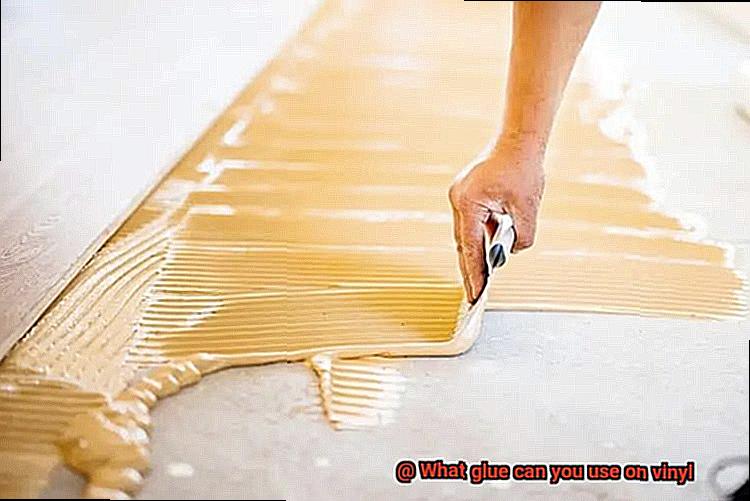
Specialized Glues for Specific Applications
Specialized glues for specific applications are a game-changer in the world of bonding materials. Whether you’re a vinyl enthusiast or a DIY aficionado, these glues are designed to meet the unique needs of different materials and applications, providing strong and durable bonds that regular glues simply can’t match.
One popular option for bonding vinyl materials is vinyl adhesive, also known as vinyl cement. This versatile glue is specially formulated to bond vinyl materials together, ensuring a bond that can withstand the test of time. With its liquid form, vinyl adhesive can be easily applied using a brush or applicator. It works by softening the surface of the vinyl, allowing it to meld with the adhesive and form a super-strong bond as it dries. From repairing vinyl seat covers to creating custom vinyl projects, vinyl adhesive is the go-to choice for all your vinyl bonding needs.
Another specialized glue for vinyl is contact adhesive. This multitasking glue can be used on various materials, including vinyl. Applying contact adhesive is a breeze – simply coat both surfaces being bonded and allow them to dry before joining them together. The result? An instant bond that will hold your vinyl materials in place like a champ. Just make sure to clean those surfaces thoroughly beforehand to avoid any pesky lifting or peeling.
For those seeking unparalleled strength and durability, epoxy glue is the ultimate choice. Made up of two components – resin and hardener – epoxy glue creates a chemical reaction when mixed together, resulting in an indestructible bond. Epoxy glue can withstand water, chemicals, heat, and pretty much anything else life throws at it. However, it requires careful handling and precise mixing according to the manufacturer’s instructions.
But wait, there’s more. Multipurpose adhesives are another option for bonding vinyl materials. These versatile glues can be used on various materials, including vinyl, wood, metal, and more. They come in convenient tube or cartridge form and can be applied with ease using a caulk gun or similar applicator. Just be sure to choose a multipurpose adhesive that is suitable for vinyl bonding, as some may not provide as strong of a bond as specialized vinyl glues.
It’s important to note that certain types of vinyl, such as PVC or vinyl flooring, may require specific adhesives designed specifically for those materials. So, always consult the manufacturer’s recommendations or seek professional advice when working with these types of vinyl materials to ensure the best results.
Applying the Glue to Vinyl
Vinyl, a versatile and popular material used in various applications, requires the right adhesive to ensure a strong and durable connection. In this step-by-step guide, we will walk you through the process of applying glue to vinyl, providing you with all the necessary information for successful adhesion every time.
Step 1: Choose the Right Glue
To start off, it is crucial to select a glue specifically designed for bonding vinyl. Solvent-based adhesives, such as vinyl cement or cyanoacrylate glue, are commonly recommended for their ability to create a strong and long-lasting bond. Ensure compatibility by checking the label or consulting with the manufacturer.
Step 2: Prepare the Surface
Before applying the glue, take the time to prepare the surface of the vinyl. Gently clean it using a mild detergent and water solution to remove any dirt or debris. Avoid harsh cleaning agents or abrasive materials that can scratch or damage the surface.
Step 3: Apply the Glue
Using a small brush or sponge applicator, apply a thin and even layer of glue onto one of the surfaces you want to bond together. Be cautious not to overapply, as excess adhesive can seep out and create an unsightly mess.
Step 4: Align and Press
Carefully align the two surfaces that need to be bonded and firmly press them together. The absence of air bubbles between the surfaces is crucial, as they can weaken the bond. To ensure proper contact, consider using a roller or applying gentle pressure with your hands.
Step 5: Allow Drying and Curing Time
After bonding the vinyl pieces together, it is essential to allow sufficient time for the glue to dry and cure. The drying time may vary depending on the adhesive used, so consult the manufacturer’s instructions. Avoid placing stress or strain on the glued area until the adhesive has fully cured.
pkOMxSPcTtE” >
Conclusion
When it comes to gluing vinyl, you need a strong adhesive that can withstand the unique properties of this material. One excellent option is a vinyl adhesive specifically designed for bonding vinyl surfaces. This type of glue is formulated to provide a secure and long-lasting bond on vinyl, ensuring your projects stay intact.
Another option is using a multipurpose adhesive that works on various materials, including vinyl. These types of adhesives are often versatile and can be used for different projects around the house. However, it’s crucial to check the label or product specifications to ensure it is suitable for use on vinyl.
Additionally, some people have had success with super glue or cyanoacrylate adhesive when working with small vinyl pieces or repairs. These adhesives dry quickly and create a strong bond, making them ideal for quick fixes.
It’s important to note that not all glues are suitable for use on vinyl. Avoid using solvent-based adhesives or those containing harsh chemicals as they can damage the material. Always read the instructions and choose an adhesive specifically formulated for use on vinyl surfaces.
In conclusion, when it comes to gluing vinyl, opt for a specialized vinyl adhesive or a multipurpose adhesive that is compatible with this material. Remember to follow the instructions carefully and choose an adhesive that provides a secure and long-lasting bond.

